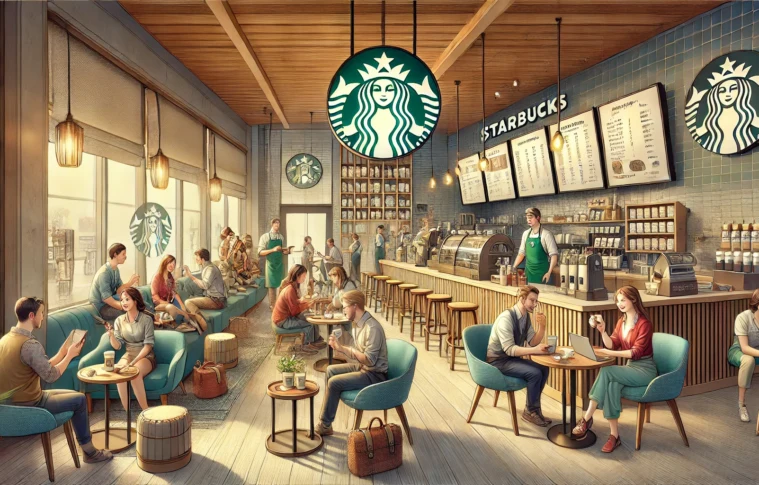Starbucks is one of the most recognizable brands globally, and a significant part of its success can be attributed to its ability to create a “third place” where customers feel valued, relaxed, and at home. This case study analyzes how Starbucks has masterfully used customer experience, loyalty-building strategies, and emotional connections to develop a cult following.
1. Creating the “Third Place” Experience
Starbucks revolutionized the coffee shop industry by introducing the concept of the “third place” – a space that is neither home nor work, but somewhere people can feel comfortable, unwind, and connect. This concept has been integral to Starbucks’ strategy and has helped the brand foster loyalty in an otherwise transactional industry. Here’s how they did it:
- Atmosphere and Ambiance: Starbucks locations are designed to be cozy and inviting. Whether it’s the soft lighting, the comfortable seating, or the background music, every detail is tailored to encourage people to spend time in-store. This creates a sense of community and belonging.
- Personalization: Starbucks employees (or “partners,” as they are called) are trained to engage with customers on a personal level. Many customers feel special when a barista remembers their name or their usual order. This personalized touch deepens the emotional connection and reinforces the brand’s commitment to making each customer feel valued.
2. Focus on Customer-Centric Innovations
Starbucks has also been innovative in understanding customer needs and using technology to enhance their experience:
- Mobile Ordering and the Starbucks App: Starbucks was one of the first major coffee chains to embrace mobile ordering, which has helped streamline the ordering process. The app allows customers to order ahead, pay online, and pick up their drinks without waiting in line. This efficiency appeals to busy customers who want a seamless experience.
- Loyalty Programs: Starbucks’ Rewards program has been instrumental in driving repeat business. Customers earn Stars for every purchase, which can be redeemed for free drinks and food. The program offers personalized promotions, exclusive offers, and birthday rewards, which create a sense of exclusivity.
3. Emotional Branding and Customer Loyalty
Starbucks has become more than just a coffee shop – it’s a lifestyle brand. Through its consistent messaging, it has built an emotional connection with its customers:
- Storytelling and Brand Identity: Starbucks emphasizes its roots in coffee culture and sustainability. Its branding often focuses on its role in supporting ethical coffee sourcing, environmental initiatives, and community-building. This narrative resonates with customers who want to feel that their purchases are contributing to something meaningful.
- Social Responsibility: Starbucks is known for its commitment to social causes, whether through environmental sustainability, fair trade practices, or creating job opportunities. This focus on corporate social responsibility enhances the brand’s image and makes customers feel aligned with the company’s values.
4. Consistency Across Locations
Starbucks is known for providing a consistent experience no matter where you are in the world. Whether you’re in New York, Tokyo, or Paris, you can expect the same quality of coffee, similar store layout, and friendly service. This consistency helps build trust and makes customers feel comfortable wherever they go.
5. Community Engagement and Social Media
Starbucks has built an active online community where customers can engage with the brand:
- Social Media Presence: Starbucks has mastered the art of social media engagement. It actively communicates with customers, promotes new products, and encourages user-generated content. Starbucks’ Instagram page, for example, showcases visually appealing drinks and customer stories.
- Contests and Campaigns: Starbucks often runs campaigns that involve customers in the creative process, such as naming a new drink or voting on a new flavor. These participatory efforts make customers feel like they are part of the brand’s evolution.
6. Adapting to Market Trends
Starbucks has shown remarkable adaptability in staying relevant to new consumer trends. Whether it’s the increasing demand for plant-based options, healthier beverages, or sustainability in packaging, Starbucks is quick to respond to market shifts and adapt its product offerings.
Results: Building a Cult Following
- Brand Loyalty: Starbucks has one of the most loyal customer bases in the world. Its Rewards program, combined with personalized service and customer engagement, has led to high levels of repeat business.
- Expansion and Growth: Starbucks has grown exponentially, with over 33,000 locations worldwide. Its ability to foster customer loyalty has played a crucial role in its global success.
- Emotional Connection: Starbucks customers are not just buying coffee – they are investing in an experience, a lifestyle, and a brand they believe in.
Conclusion:
Starbucks’ ability to create a “third place” and foster loyalty is a testament to the power of customer experience in building a brand that resonates emotionally. By focusing on personalization, innovation, social responsibility, and consistency, Starbucks has created a community of passionate followers who are more than just customers – they are brand advocates.



